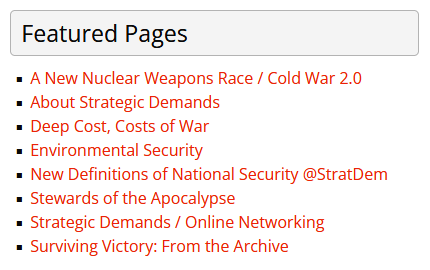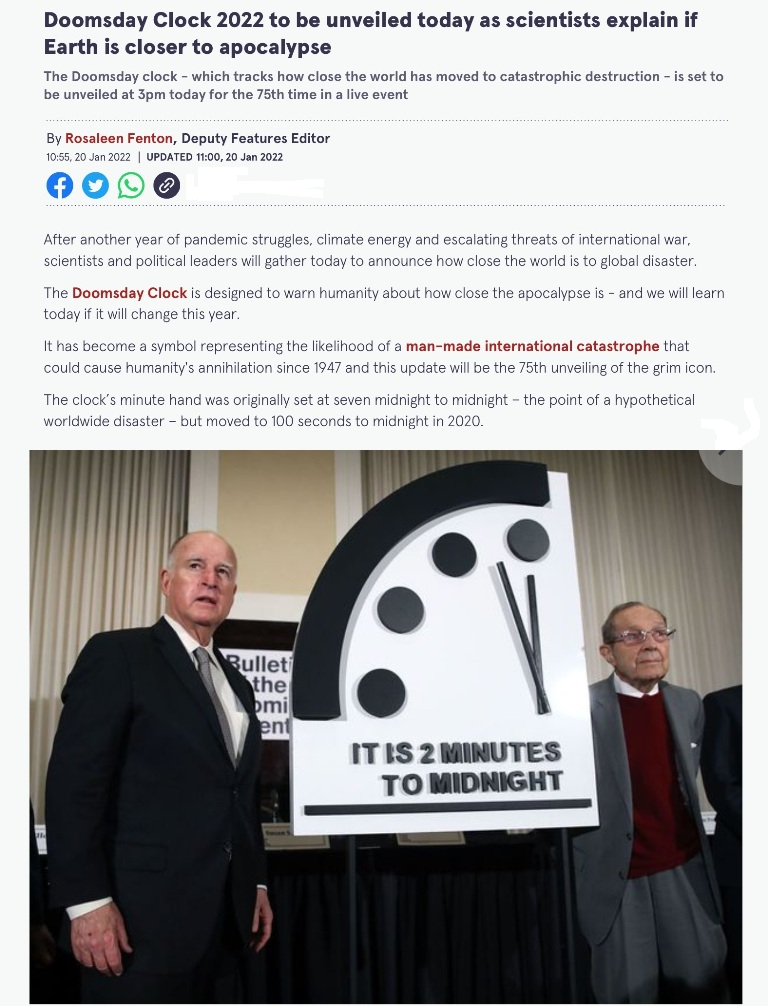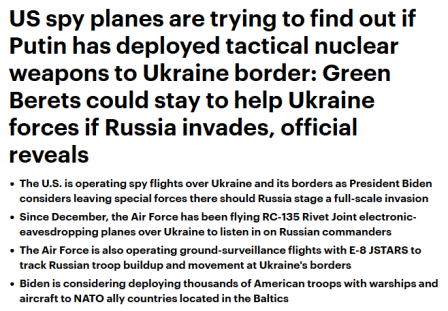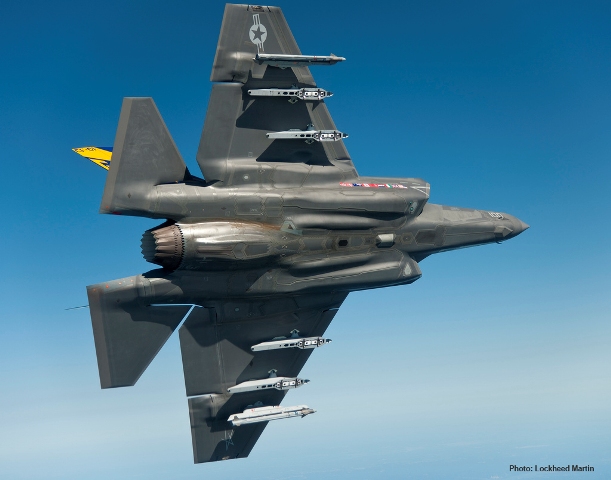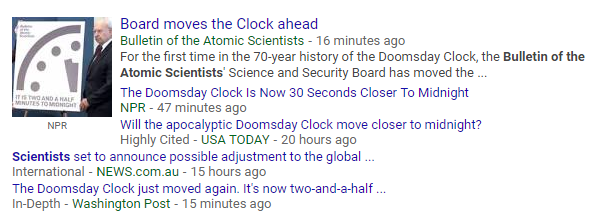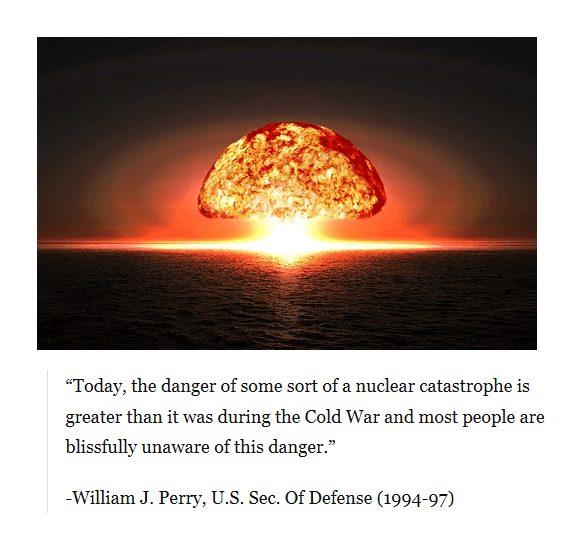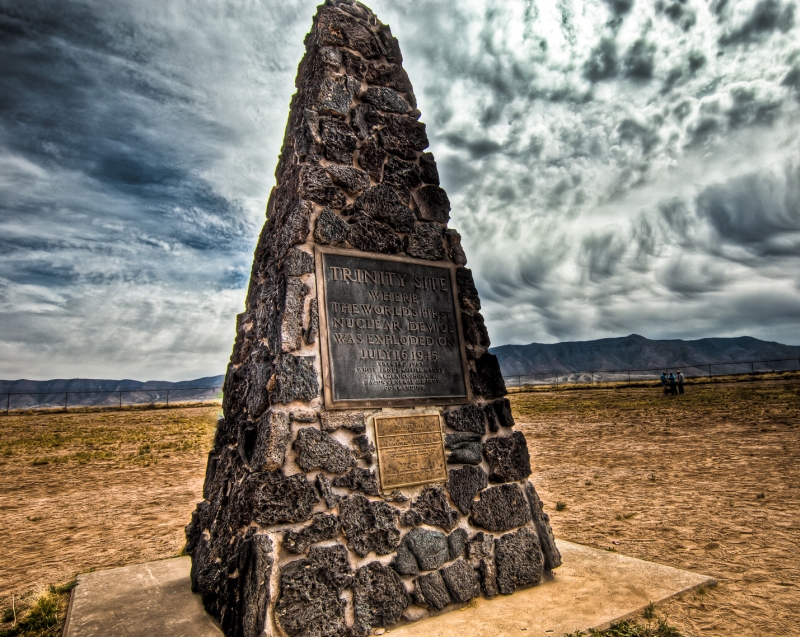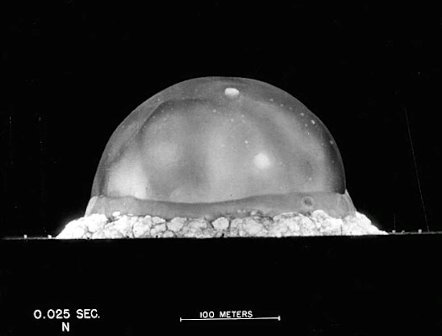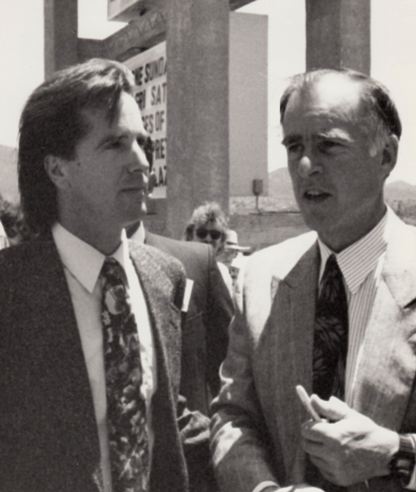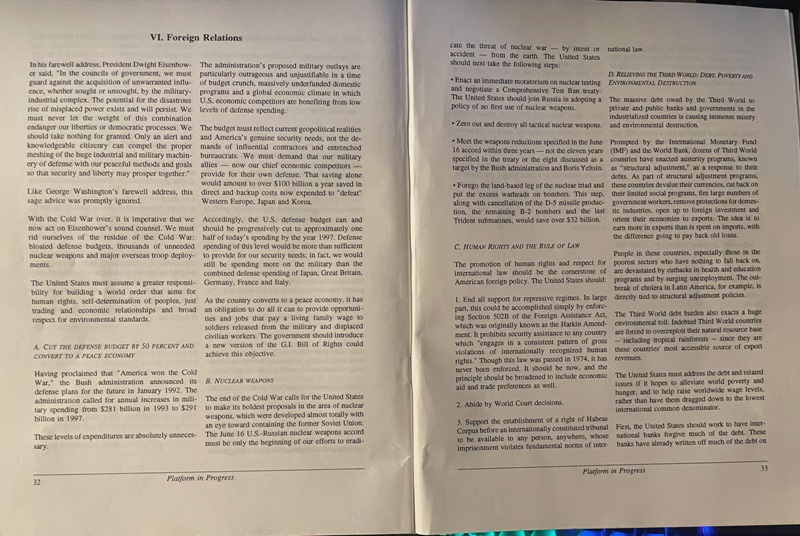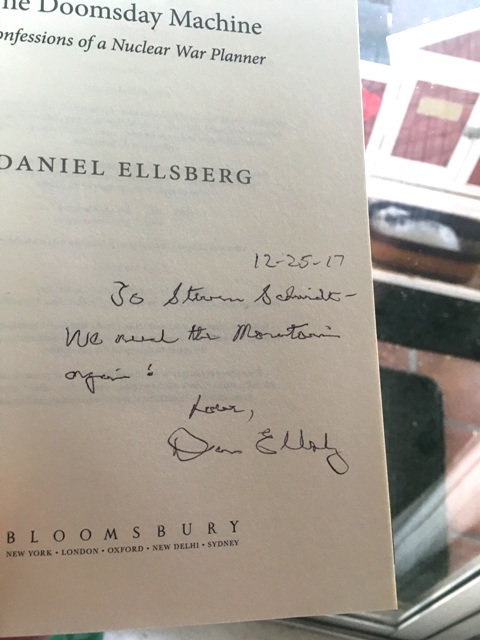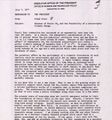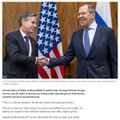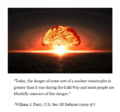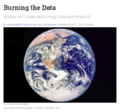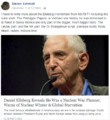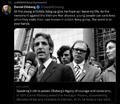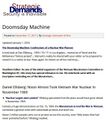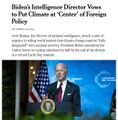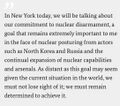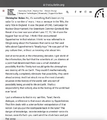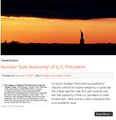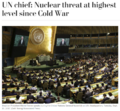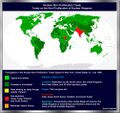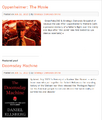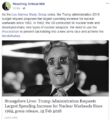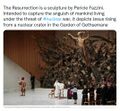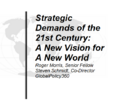Category:Nuclear Proliferation
Strategic Demands
- A New Nuclear Weapons Race / Cold War 2.0
Nuclear Proliferation vs Nuclear Nonproliferation
In the Nuclear Age the Question of the Hour...Day...Year...Century is.... Security
- “If you are talking about a nuclear-armed environment, which is already fragile … then you are living in an environment [where] things could escalate quite quickly, by accident or miscalculation.”
Last week [Jan. 20, 2022], the Bulletin of the Atomic Scientists cited the Ukraine conflict as contributing to its decision to keep the “Doomsday Clock” at 100 seconds to midnight, an indication of how close it assesses that the human race is to potential self-annihilation.
“Ukraine remains a potential flashpoint, and Russian troop deployments to the Ukrainian border heighten day-to-day tension,” it noted in citing the threat of a nuclear conflict.
A primary concern... is Russia’s arsenal of thousands of battlefield nuclear weapons, which are central to its military strategy.
“The Russians have something like 4,000 [tactical nuclear weapons] and they have an ‘escalate to win’ nuclear doctrine, which says ‘we use nuclear weapons first if the conventional conflict starts to spin out of our favor,’” said a former senior GOP government official who still works on nuclear security issues.
One Russian diplomat last month went so far as to publicly threaten the deployment of tactical nuclear weapons in the crisis.
The weapons have a lower “yield” than traditional atomic bombs and are designed to be used against conventional forces in battle. But they still have enormous explosive power and are considered particularly destabilizing to deterrent strategy.
The United States has reportedly been flying dedicated spy missions over in recent weeks to determine if Russia has deployed any of its tactical nuclear weapons along the border with Ukraine.
Nuclear Proliferation
Nuclear Weapons, Generational Risks of Disaster: When Will the 'Big One' Come?
2017
A continuing concern at GreenPolicy360's associated site Strategic Demands is the "modernization" of the US nuclear weapons capabilities, in particular, 'dial up' usable cruise missiles and 'smart' add-on upgrades to the B61 nuclear weapon system.
After the end of the Soviet Union and beginning of the Russian Federation in the 1990s, the opening for a "peace dividend", a drawdown became possible of nuclear weapons in a histioric transition from a nuclear weapons 'Mutual Assured Destruction' (MAD) strategies and deployment. This moment passed even as former Soviet states returned nuclear weapon system to the Russian Federation and the forces of NATO, the U.S. and Europe were realigned.
Within years, however, a new Cold War, a new nuclear weapons era, began. A Cold War 2.0 emerged out of the turn of the Century. Computer networks, 'smart' and advanced command and control systems, a next generation of nuclear weapons were rolled out and deployed. Russia reformed, China entered the nuclear race with powerful technology, the U.S. announced successive nuclear weapons development 'modernization' that acted to spur international quid pro quo responses.
*http://nukewatch.org/B61.html
The consequences of the forward-deployment of next generation nuclear weapons will continue, as it has for years now, to bring a reciprocal response, both from Russia and China. A new nuclear arms race has commenced, a "Cold War 2.0" with escalating risks and regional flashpoints growing more dangerous, year by year.
"Events... have led to the worsening of an already difficult climate for discussions on the issue of removal of American B61 gravity bombs deployed in five European states.
"Existing defense and deterrence mechanisms, international legal and allied security guarantees and assurances, and their viability and effectiveness, have been subject to renewed examination..."
"Against such a climate of uncertainty, insecurity and confrontation it is difficult to imagine a serious consideration of prospects for nuclear disarmament in Europe by political leaders from NATO member states."
* http://fas.org/programs/ssp/nukes/publications1/Brief2013_B61-12.pdf
* http://fas.org/blogs/security/2014/01/b61capability/
* http://defensetech.org/2014/02/28/nuclear-bomb-upgrade-could-violate-key-treaty/ -- http://www.spiegel.de/international/world/upgrading-us-nuclear-weapons-more-expensive-than-planned-a-833586.html
* http://www.greenpolicy360.net/w/File:B61_before_tail_kit.jpg -- http://strategicdemands.com/going_bzhrk/
NUKES on F-35 I New Strike Fighters
Ⅰ Ⅱ Ⅲ Ⅳ Ⅴ Ⅵ Ⅶ Ⅷ Ⅸ Ⅹ Ⅺ Ⅻ ⅰ ⅱ ⅲ ⅳ ⅴ ⅵ ⅶ ⅷ ⅸ ⅹ
Ⅰ Ⅱ Ⅲ Ⅳ Ⅴ Ⅵ Ⅶ Ⅷ Ⅸ Ⅹ Ⅺ Ⅻ ⅰ ⅱ ⅲ ⅳ ⅴ ⅵ ⅶ ⅷ ⅸ ⅹ
From GreenPolicy's Associate -- Strategic Demands
- ○ ○ ○ ○ ○ ○ ○ ○ ○ ○ ○ ○ ○ ○ ○ ○ ○ ○ ○ ○ ○ ○ ○ ○ ○ ○ ○
- ○ ○ ○ ○ ○ ○ ○ ○ ○ ○ ○ ○ ○ ○ ○ ○ ○ ○ ○ ○ ○ ○ ○ ○ ○ ○ ○ ○
Ⅰ Ⅱ Ⅲ Ⅳ Ⅴ Ⅵ Ⅶ Ⅷ Ⅸ Ⅹ Ⅺ Ⅻ ⅰ ⅱ ⅲ ⅳ ⅴ ⅵ ⅶ ⅷ ⅸ ⅹ
- 2016 / The 'Doomsday Clock'
∆∆∆∆∆ ▲▲▲▲▲▲▲▲▲▲▲ ∆∆∆∆∆
Memories of a Son of the Nuclear Age
Beginnings in1945
Trinity
The Nuclear Age 'Begat'
On 75th Anniversary of the First Test of a Nuclear Bomb
July 16, 1945 - July 16, 2020
∆∆∆∆∆ ▲▲▲▲▲▲▲▲▲▲▲ ∆∆∆∆∆
Memories of Presidential Campaigns with California Governor Brown and Failed Attempts to Shift National Policies
GreenPolicy360 Siterunner: The dangers of Nuclear Proliferation have been ever present since the 1960s with our generation. Gov. Jerry Brown's national campaigns in 1976, 1980, and 1992 were moments to put forward policy platforms offering profound change in U.S. foreign policy and national security. The move away from nuclear weapons remains a constant vision of ours decades later...
- https://www.greenpolicy360.net/w/Governor_Jerry_Brown
- https://www.greenpolicy360.net/w/File:Jerry_Brown_92_Presidential_Platform_We_the_People.jpg
- https://www.greenpolicy360.net/w/File:Jerry_w_Steve_%2792_pres_campaign_at_the_Dem_plat_hearing_m.jpg
- https://strategicdemands.com/?s=jerry+brown
- https://strategicdemands.com/nuclear-end-of-times-scenario/
GreenPolicy360 siterunner Steve Schmidt w/ Calif Gov. Brown
1992 Presidential Campaign
Governor Edmund (Jerry) Brown Brings Forward a Policy Platform of Nuclear Nonproliferation
SJS / Advancing a presidential campaign, your GreenPolicy360 siterunner worked with the Governor to draft the 'We the People' campaign platform, taking new ideas into the U.S. presidential debate to press the Democratic Party in a 21st Century direction...
At the Democratic Party Platform Hearings
Advancing a new nuclear foreign policy for a post Cold War world
1992 Presidential Campaign Platform
- of Governor Edmund G. 'Jerry' Brown Jr.
Excerpt from the Brown for President "Platform in Progress" - 1992
IV. Foreign Relations
In his farewell address, President Dwight Eisenhower said, "In the councils of government, we must guard against the acquisition of unwarranted influence, whether sought of unsought, by the military-industrial complex. The potential for the disastrous rise of misplaced power exists and will persist. We must never let the weight of this combination endanger our liberties or democratic process. We should take nothing for granted. Only an alert and knowledgeable citizenry can compel the proper meshing of the huge industrial and military machinery of defense with our peaceful methods and goals so that security and liberty may prosper together."
Like George Washington's farewell address, this sage advice was promptly ignored.
With the Cold War over, it is imperative that we now act on Eisenhower's sound counsel. We must rid ourselves of the residue of the Cold War: bloated defense budgets, thousands of unneeded nuclear weapons and major overseas troop deployments.
The United States must assume a greater responsibility for building a world order that aims for human rights, self-determination of peoples, just trading and economic relationships and broad respect for environmental standards.
A. CUT THE DEFENSE BUDGET BY 50 PERCENT AND CONVERT TO A PEACE ECONOMY
Having proclaimed that "America won the Cold War," the Bush administration announced its defense plans for the future in January 1992. The administration called for annual increases in military spending from $281 billion in 1993 to $291 billion in 1997.
These levels of expenditures are absolutely unnecessary.
The administration's proposed military outlays are particularly outrageous and unjustifiable in a time of budget crunch, massively underfunded domestic programs and a global economic climate in which U.S. economic competitors are benefiting from low levels of defense spending.
The budget must reflect current geopolitical realities and America's genuine security needs, not the demands of influential contractors and entrenched bureaucrats. We must demand that our military allies -- now our chief economic competitors -- provide for their own defense. That saving alone would amount to over $100 billion a year saved in direct and backup costs now expended to "defeat" (and "protect") Western Europe, Japan and Korea.
Accordingly, the U.S. defense budget can and should be progressively cut to approximately one half of today's spending by the year 1997. Defense spending of this level would be more than sufficient to provide for our security needs; in fact, we would still be spending more on the military than the combined defense spending of Japan, Great Britain, Germany, France and Italy.
As the country converts to a peace economy, it has an obligation to do all it can to provide opportunities and jobs that pay a living family wage to soldiers released from the military and displaced civilian workers. The government should introduce a new version of the G.I. Bill of Rights that could achieve this objective.
B. NUCLEAR WEAPONS
The end of the Cold War call for the United States to make its boldest proposals in the area of nuclear weapons, which were developed almost totally with an eye toward containing the former Soviet Union. The June 16 U.S.-Russian nuclear weapons accord must be only the beginning of our efforts to eradicate the threat of nuclear war -- by intent or accident -- from the earth. The United States should next take the following steps:
- Enact an immediate moratorium on nuclear testing and negotiate a Comprehensive Test Ban treaty. The United States should join Russia in adopting a policy of no first use of nuclear weapons.
- Zero out and destroy all tactical nuclear weapons.
- Meet the weapons reductions specified in the June 16 accord within three years -- not the eleven years specified in the treaty or the eight discussed as a target by the Bush administration and Boris Yeltsin.
- Forego the land-based leg of the nuclear triad and put the excess warheads on bombers. This step, along with cancellation of the D-5 missile production, the remaining B-2 bombers and the last Trident submarines would save over $32 billion.
C. HUMAN RIGHTS AND THE RULE OF LAW
The promotion of human rights and respect for international law should be the cornerstone of American foreign policy. The United States should:
1. End all support for repressive regimes. In large part, this could be accomplished simply by enforcing Section 502B of the Foreign Assistance Act, which was originally known as the Harkin Amendment. It prohibits security assistance to any country which "engages in a consistent pattern of gross violations of internationally recognized human rights." Though this law was passed in 1974, it has never been enforced. It should be now, and the principle should be broadened to include economic aid and trade preferences as well.
2. Abide by World Court decisions.
3. Support the establishment of a right of Habeas Corpus before an internationally constituted tribunal to be available to any person anywhere, whose imprisonment violates fundamental norms of international law.
D. RELIEVING THE THIRD WORLD: DEBT, POVERTY AND ENVIRONMENTAL DESTRUCTION
The massive debt owed by the Third World to private and public banks and governments in the industrialized countries is causing immense misery and environmental destruction.
Prompted by the International Monetary Fund (IMF) and the World Bank, dozens of Third World countries have enacted austerity programs, known as "structural adjustment," as a response to their debts. As part of structural adjustment programs, these countries devalue their currencies, cut back on their limited social programs, fire large numbers of government workers, remove protections for domestic industries, open up to foreign investment and orient their economies to exports. The idea is to earn more in exports than is spent on imports, with the difference going to pay back old loans.
People in these countries, especially those in the poorest sectors who have nothing to fall back on, are devastated by cutbacks in health and education programs and by surging unemployment. The outbreak of cholera in Latin America, for example, is directly tied to structural adjustment policies.
The Third World debt burden also exacts a huge environmental toll. Indebted Third World countries are forced to overexploit their natural resource base -- including tropical rainforsts -- since they are these countries' most accessible source of export revenues...
○
A Father's Story from 1945 and the First Nuclear Bomb
GreenPolicy360 Siterunner: In the second World War my father, Joseph Schmidt, was a bomber pilot trained to fly "secret missions."
He spoke to me, on rare occasions, about his training and B-17/29 "special" assignments near war's end.
One day and one story stands out in my memory. Posterity tells me to share his story as my dad has passed away.
War secrets have long faded into history. Marfa/Roswell/Ardmore/Clovis/Alamogordo -- B-17s to B-29s -- missions to the Pacific...
It was in July 1945. At that time my lieutenant father was based in New Mexico at Clovis Army Air Field flying training missions. He was scheduled, as I look today at his yellowing papers with orders in his air force trunk, to transfer to Alamogordo on July 23rd. Curiously, I see a number of destinations on his orders are blank. I'm remembering how he told me that he knew and his crew knew, in their own way, about the first test of a nuclear weapon. They knew it had happened not far from their base and on July 17th newspapers in New Mexico had reported that a "munitions storage depot" had exploded. This was the official line to explain the bright flash in the sky at dawn, 5:30 AM on July 16th, south of Albuquerque.
The initial testing of the first nuclear weapon was at Trinity -- https://en.wikipedia.org/wiki/Trinity_(nuclear_test) -- in a barren area of New Mexico known as Jornada del Muerto ("Journey of the Dead Man"). The desolation made it the choice of the Army and scientists who had secretly developed the bomb at the isolated nuclear physics laboratory at Los Alamos.
The B-17 crew that flew that week from Clovis decided (in a departure from the official planned flight path) to veer "off course" and to take a look at the area where the bomb went off... not a good decision, but in those days many of the pilots and crews were strong willed to put it mildly. This crew chose to go where they thought the site of the blast was... They scanned the horizon and in the distance they saw a bright glistening spot in the desert.
They flew over it. My father, years later, told me it was both frightening and beautiful. It was a crater scattering radiating beams of light up.
The crater from the blast shocked the crew into silence he remembered. The sand had turned liquid then fused and fallen back to earth. The crater was coated with a 'glass' that would be called "Trinitite".
They flew on without talking, he said. The power of the weapon all too evident. No more fly-boys on a run.
Now they knew what their bomber group, their B-29s, and their special runs with unusual maneuvers were being equipped to do. The military covered over the crater and evidence of the blast.
Then they heard the news, August 6th and 9th, 1945, the atomic bombings of Hiroshima and Nagasaki, Japan.
○
Memories of a Nuclear War Planner
Knowing Dan Ellsberg, hearing his war stories up close and personal
Dan Ellsberg
- https://www.greenpolicy360.net/w/File:Doomsday_Machine.jpg
- https://www.greenpolicy360.net/w/File:Doomsday_Machine-Daniel_Ellsberg-Recalling_the_Vietnam_Moratorium_Oct-Nov_1969.jpg
- https://www.greenpolicy360.net/w/File:Moratorium_memory,_Dan-Steve,_Doomsday_Machine_inscription.jpg
Subcategories
This category has the following 6 subcategories, out of 6 total.
Pages in category "Nuclear Proliferation"
The following 29 pages are in this category, out of 29 total.
G
- George E. Brown Jr
- Google Earth Timelapse
- Green Institute
- Green Stories of the Day
- Green Stories of the Day - GreenPolicy360 Archive
- GreenPolicy360 Archive Highlights 2013
- GreenPolicy360 Archive Highlights 2014
- GreenPolicy360 Archive Highlights 2015
- GreenPolicy360 Archive Highlights 2016
- GreenPolicy360 Archive Highlights 2017
- GreenPolicy360 Archive Highlights 2018
- GreenPolicy360 Archive Highlights 2019
- GreenPolicy360 Archive Highlights 2020
- GreenPolicy360 Archive Highlights 2023
N
Media in category "Nuclear Proliferation"
The following 172 files are in this category, out of 172 total.
- 100 seconds to midnight.jpg 768 × 432; 30 KB
- 1977 from the Office of Science and Technology Policy.jpg 661 × 711; 177 KB
- A Film About the Power of Protest.png 800 × 801; 715 KB
- A Stark Nuclear Warning from William J Perry.png 579 × 185; 55 KB
- A Stark Nuclear Warning.png 554 × 804; 171 KB
- A Ukraine Russia US Nato fix.png 800 × 519; 275 KB
- A Very Close Call Cuban Missile Crisis.jpg 582 × 459; 0 bytes
- About the Doomsday Clock.png 361 × 415; 56 KB
- August 6, 1945.jpg 800 × 362; 121 KB
- B-21 Raider.jpg 789 × 515; 98 KB
- Battle for Democracy.jpg 640 × 123; 24 KB
- Bill McKibben-Fate of the Earth Inaug-New School.png 800 × 735; 303 KB
- Bill-Perry-is-terrified.-Why-arent-you Jan2016.png 768 × 440; 109 KB
- Blinken-Lavrov - Jan 21 2022.jpg 600 × 600; 117 KB
- Blissfully-Unaware.png 573 × 534; 67 KB
- Bulletin from the Los Alamos Study Group - August 2022.png 800 × 561; 559 KB
- Burning the Data.png 640 × 597; 434 KB
- Citizens Climate Lobby - Save Our Future Act 2021.jpg 518 × 262; 77 KB
- Climate and National Security.jpg 603 × 533; 157 KB
- Climate Change Poses a Widening Threat to National Security.png 600 × 781; 310 KB
- Climate debate.jpg 493 × 580; 129 KB
- Costs of War US Post 9-11 War Spending.jpg 800 × 305; 60 KB
- Cruise nukes.jpg 533 × 69; 21 KB
- Dan Ellsberg - 2017.png 503 × 548; 101 KB
- Dan Ellsberg - March 2023.png 640 × 288; 135 KB
- Dan Ellsberg - the world is in your hands.png 800 × 690; 436 KB
- Doomsday Clock - 2019 (2).png 640 × 383; 116 KB
- Doomsday Clock - 2019.png 640 × 498; 366 KB
- Doomsday Clock - 2022.png 768 × 1,006; 837 KB
- Doomsday Clock - January 2023.png 784 × 767; 519 KB
- Doomsday Clock 2023.png 622 × 600; 184 KB
- Earth Day and Climate at the Center.jpg 595 × 604; 131 KB
- Earthrise 100 Photographs That Changed the World .jpg 549 × 720; 124 KB
- Einstein letter to Roosevelt - August 2, 1939.png 1,423 × 763; 459 KB
- Environment and Security.jpg 289 × 34; 16 KB
- EnvirSecurity.png 558 × 166; 155 KB
- F35-payloads.jpg 636 × 479; 66 KB
- Fact Checking organizations at work.jpg 800 × 390; 44 KB
- Facts Count-WaPo Reports-19127 false-misleading claims in 1226 days.jpg 601 × 489; 100 KB
- February 2023 - End of START and Nuclear Arms Control.png 800 × 315; 66 KB
- German foreign minister Baerbock calls for end of nukes.png 579 × 480; 377 KB
- German foreign minister Baerbock on nuclear non proliferation.jpg 541 × 480; 57 KB
- Greg Mello.jpg 312 × 234; 21 KB
- Hair trigger.png 714 × 397; 106 KB
- I don't think he's bluffing 2.png 448 × 380; 77 KB
- IAEA banner.png 425 × 112; 137 KB
- IAEA flag.png 2,000 × 1,333; 120 KB
- INF treaty to end.png 640 × 420; 429 KB
- Interview w Christopher Nolan - via Bulletin of Atomic Scientists.png 600 × 671; 237 KB
- Joe Biden is projected winner Nov7-2020.jpg 343 × 120; 26 KB
- LASG Nuclear Report-SJS May 9, 2018.png 490 × 1,000; 98 KB
- Last Days in Office, Last Days to Advance Nuclear Nonproliferation.png 493 × 385; 175 KB
- Los Alamos Study Group - 2021 cont..png 680 × 292; 24 KB
- LRSOs.jpg 1,024 × 616; 308 KB
- Major Kong Rides The Bomb.jpg 499 × 301; 18 KB
- March for Science-1.png 800 × 291; 596 KB
- Marshall Islands ev.png 846 × 424; 911 KB
- Memories of Big Science advocates in the US Congress.jpg 583 × 279; 87 KB
- Message from the California Governor Brown.jpg 735 × 350; 76 KB
- Moratorium memory, Dan-Steve, Doomsday Machine inscription.jpg 480 × 640; 85 KB
- My First Order.png 625 × 350; 58 KB
- My-Journey-at-the-Nuclear-Brink Perry-235x300.png 235 × 300; 43 KB
- New Definitions of National Security demanded - January 2022.png 288 × 146; 21 KB
- New Definitions of National Security.png 447 × 198; 9 KB
- New START - January 26, 2021.jpg 722 × 375; 92 KB
- New START- January-27-2021.jpg 724 × 507; 175 KB
- New-START-January-26-2021.jpg 583 × 424; 105 KB
- Nowhere to Hide.jpg 800 × 405; 53 KB
- NPT - Aug 2022.PNG 451 × 664; 147 KB
- Nuclear Issues.png 601 × 219; 36 KB
- Nuclear plutonium pit.jpg 570 × 570; 148 KB
- Nuclear sole authority of the US president.jpg 718 × 745; 120 KB
- Nuclear symbol .png 425 × 402; 11 KB
- Nuclear Threat Sept 19, 2017.png 800 × 741; 1.09 MB
- Nuclear Threats and Responses.png 724 × 448; 138 KB
- Nuclear war - small nukes are a misnomer - Potsdam.png 480 × 505; 442 KB
- Nuclear warhead - 2009 - Conf on Disarmament.jpg 800 × 621; 90 KB
- Nuclear warhead - 2009 - Geneva image.jpg 1,131 × 875; 149 KB
- Nuclear weapon pit.png 315 × 241; 83 KB
- Nuclear Weapons testing again...May 2020... madness.jpg 567 × 493; 78 KB
- Nuclear-weapons-chart 2016.jpg 697 × 526; 72 KB
- NuclearNonProliferationTreaty.jpg 1,001 × 942; 179 KB
- NuclearSymbol.png 200 × 240; 5 KB
- Nukes put on high alert.png 640 × 267; 85 KB
- Oct 15, 1969, Vietnam Moratorium Day in memory.jpg 800 × 537; 156 KB
- One Year of War.png 774 × 388; 43 KB
- Oppenheimer -- the 2023 movie and in the 1940s.png 705 × 408; 253 KB
- Oppenheimer movie - 2023.jpg 600 × 768; 124 KB
- Oppenheimer, and the Doomsday Machine.png 703 × 830; 195 KB
- Oppenheimer.png 372 × 255; 62 KB
- Over the Mid East Christmas eve, 2015.jpg 398 × 358; 0 bytes
- Over the Pacific August 2015.png 800 × 441; 685 KB
- Over the Pacific.png 800 × 441; 617 KB
- PBS Documentary - Movement and the Madman 6.png 800 × 453; 757 KB
- Post from Richard Falk, Global Justice - Oct 25 2022.jpg 469 × 133; 42 KB
- Profits of War - $14 Trillion - Read the Brown Univ-Watson Instit Report.PNG 800 × 1,002; 261 KB
- Proliferation.jpg 257 × 128; 7 KB
- Radiation Symbol.png 336 × 416; 48 KB
- Re the Doomsday Clock 1991 setting farthest from midnight.jpg 576 × 180; 84 KB
- Reaching Critical Will-LASG PressRelease-Feb12,2018.png 495 × 533; 145 KB
- Recollections of the Satan Sarmat.png 654 × 856; 216 KB
- Russia threats re nuclear weapons (2) - Apr 17 2022.png 640 × 724; 375 KB
- Russia threats re nuclear weapons - Apr 17 2022.png 640 × 298; 147 KB
- Russia-US intermediate range nuclear forces treaty-INF in danger.png 629 × 480; 245 KB
- Russian Orthodox Church Patriarch Kirill.png 640 × 329; 93 KB
- Sagan - re nuclear weapons gambling.jpg 680 × 397; 76 KB
- Sarmat intercontinental ballistic missile - Apr 20 2022.png 480 × 607; 307 KB
- Scene-oppenheimer-albert-einstein-1001343664.jpg 640 × 427; 168 KB
- Singapore-meeting-kim-trump-june-2018-768x432.jpg 768 × 432; 68 KB
- Spend Russia and China into oblivion.jpg 608 × 303; 43 KB
- Stanislav Petrov.jpg 768 × 506; 57 KB
- StatueofLiberty StrategicDemands.jpg 800 × 241; 11 KB
- Stephen Hawking Genius on PBS 1.jpg 800 × 474; 77 KB
- Stephen Hawking-Genius-2016.jpg 250 × 339; 27 KB
- Story telling and science education.png 515 × 480; 171 KB
- StratDem logo.png 316 × 100; 30 KB
- StratDem logo2a.png 242 × 70; 16 KB
- StratDem logo4.png 316 × 100; 10 KB
- StratDem Proposed Russia-Ukraine Fix.png 480 × 535; 126 KB
- StratDem Q3-Q4 2017.png 383 × 599; 80 KB
- Strategic Demands - Featured Pages.png 430 × 270; 26 KB
- Strategic Demands - GreenPolicy360 - forward looking vision.png 172 × 290; 84 KB
- Strategic Demands - Russia, Ukraine, Belarus, NATO, EU, US.png 800 × 540; 145 KB
- Sunflower fields m.jpg 640 × 320; 69 KB
- Sunflowers Ukraine.jpg 799 × 759; 275 KB
- Supermoon over Washington Monument photo by J.David Ake.png 585 × 294; 164 KB
- Surviving Victory conf Sept20,2006.pdf ; 2.16 MB
- Surviving Victory-New Definitions of National Security.png 640 × 181; 51 KB
- Surviving Victory.png 714 × 128; 41 KB
- Tactical nukes question - as of January 28 2022.png 448 × 311; 115 KB
- The Movement and the Madman - PBS - March 2023.png 503 × 388; 33 KB
- The U.S. Role in the World ... Congressman George E Brown - 1969.jpg 448 × 334; 104 KB
- There is no plan B because....png 575 × 308; 115 KB
- Think about that.png 601 × 400; 51 KB
- Think-about-that.png 601 × 400; 30 KB
- Thirty-seconds-closer-to-midnight.png 594 × 215; 54 KB
- Time to Advance New Definitions of National Security.jpg 652 × 833; 104 KB
- Time-Magazine-nukes cover-Feb2018-225x300.jpg 225 × 300; 14 KB
- Tracking Biden's Environmental Record - WaPo - Feb 2021.jpg 766 × 326; 64 KB
- Tracking Biden's Environmental Record - WaPo listing - Feb 2021.jpg 588 × 397; 35 KB
- Treaty to Prohibit Nuclear Weapons - Oct 2020.jpg 517 × 709; 90 KB
- Trinitite .jpg 504 × 402; 66 KB
- Trinity monument m.jpg 800 × 637; 454 KB
- Trinitytest.jpg 442 × 336; 15 KB
- Trump speaks at the UN-Sept19,2017.png 300 × 248; 88 KB
- Trump Tweet-re nuclear capability-Dec22,2016.png 525 × 239; 20 KB
- Trump-Putin-NuclearWeapons Dec22,2016 trending news.png 800 × 160; 79 KB
- Ukraine tension January 21 2022.png 684 × 209; 46 KB
- UN General Assembly Vote - March 2 2022.jpg 680 × 417; 107 KB
- US Role George E Brown 2.pdf ; 151 KB
- US Role George E Brown 3.pdf ; 157 KB
- War in the Ukraine - February 24 2022.png 731 × 307; 118 KB
- War in Ukraine Feb 26 2022.png 640 × 195; 68 KB
- War or Security - January 2022.png 448 × 231; 77 KB
- We Want You Security State investigation WaPo.png 612 × 480; 645 KB
- Zelenskyy says.png 640 × 181; 98 KB
- Anthropocene
- Eurasia
- Environmental Security
- Environmental Security, National Security
- Europe
- European Union
- Global Security
- Green Party
- Green Politics
- Middle East
- New Definitions of National Security
- North America
- Nuclear Free
- Nuclear Nonproliferation
- Nuclear Proliferation
- Nuclear Weapons
- Peace
- Radioactive Pollution
- Radioactive Waste
- Russian Federation
- Strategic Demands
- Threat Multiplier
- Whole Earth
- China
- France
- India
- Israel
- North Korea
- Pakistan
- UK
- US

